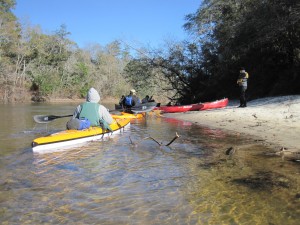When the icy fingers of winter descend many paddlers wind up retiring their canoes and kayaks to the dark recesses of the garage until spring, but with the proper gear it’s possible to paddle all year long and stay warm and dry in the process. The key is to dress for the water temperature and possible immersion rather than dress for the weather. Hypothermia and cold water shock can reduce survivability considerably.
Spray Skirts, Drysuits and Wetsuits
Sit-in kayaks are easier to weatherproof than sit-on tops and canoes simply because fitted spray skirts are readily available for purchase. The spray skirt is designed to keep the spray from wind and waves from entering the cockpit, thereby keeping the paddler dry. Spray skirts also make it easier to perform an Eskimo roll in the event of a capsize, a skill especially useful for those who sea kayak. In addition to the spray skirt paddlers will want to wear some of the gear suggested here.
For sit-on-top kayaks and canoes the easiest solution is to invest in a drysuit. These can be expensive, starting around $500 depending on brand, but are very effective in keeping the paddler dry and warm. To avoid the high cost of a drysuit some paddlers opt for a full body wet suit as a base layer beneath paddling pants and jacket. The drawback to a wetsuit is that it doesn’t keep the paddler dry, but instead helps in trapping heat next to the body.
Gloves, Booties and Hats
The next must-have for paddling is hand, feet and head protection. There are a variety of specially designed gloves, pogies (paddle mitts,) booties and head coverings available to aid in this endeavor or paddlers may decide instead to use diver-inspired Neoprene gloves and attire. No matter the product, the goal is to keep hands warm, and dexterous in cold water. Numb hands can’t grip a paddle, release spray skirts for escape or grasp a craft properly for re-entry.
PFDs and Cold Water Shock
Paddlers should also make it a practice to always wear their PFD (Personal Flotation Device), particularly in cold weather. Over the last few years a phenomena has come to light known as an “involuntary gasp reflex” which happens with cold water shock and can be as dangerous, if not more so, than hypothermia. Cold water shock can happen immediately upon immersion in cold water and the victim can drown almost instantly. A PFD can help in keeping the victim’s head above water during an unexpected capsize. Nose clips and ear plugs may also be of use.
Paddling during the colder months also brings a few more ingredients to the mix. The days are shorter, windier and paddlers use more energy on trips. The body requires more fuel in cold weather so be sure to bring extra energy bars for an extra boost. Plan for a worst case scenario, review canoeing and kayaking safety tips and dress appropriately to make winter-time paddling an enjoyable adventure.
Additional Resources:
USCG Hypothermia, Drowning, and Cold-Water Survival
This article is copyrighted by Beverly Hill

